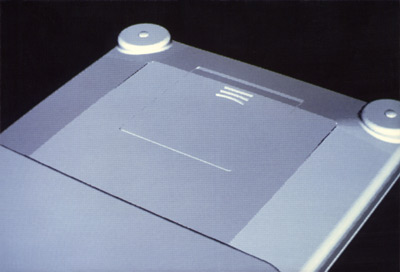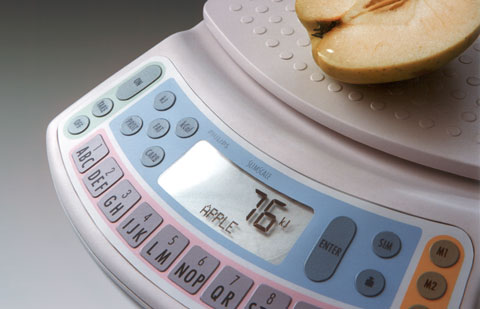
The easy-to-clean membrane switch panel keys are logically grouped and colour-coded. Weighing functions for example (on, off, tare) are green, and user memory functions yellow. To give the user tactile feedback, the keys are embossed and “click” when pushed. The Liquid Crystal Display is slightly curved; this is possible with a flexible LCD - still in the development stage when the SlimScale was designed.


The design and detailing was done with I/EMS (Intergraph Engineering Modeling System) CAD/CAM software on InterPro and InterAct workstations; very expensive and (for that era - 1989!) advanced design tools.

The scale uses what is now known as ‘predictive text input’ technology for entering the name of the foodstuff. After entering the correct foodstuff, the user can see the caloric content and other nutritional values, and add them to his day memory.
SlimScale dietary scale
The “SlimScale” dietary scale, designed as a graduation project at the Design Academy Eindhoven, is an attempt to enhance user-friendlyness. Instead of numerical codes, this scale works by keying in the first characters of the foodstuff. To this end, the scale is equipped with an alpha-numerical key-panel and LCD display, and interactive software, which will ask the user for more characters if necessary. Usually, one to four characters will suffice. The SlimScale then asks the user to confirm the displayed name, after which the content of kJ, kCal, proteins, fats or carbohydrates can be asked by pushing the accordingly marked buttons. The ten key alphanumeric key panel is numbered 1 to 0, to enable the user to add foodstuffs to the memory without actually weighing them; the user can key in an estimated quantity (of e.g. an apple eaten during work) and add it to his or her memory file, by using the simulation button.
As the dietary scale is aimed at the consumer market, where buyers might be shied away by too “scientific” an appearance, care was taken to give it a friendly look. The form of the scale joins organic elements with a look of stability.
Extensive technical and marketing information for this project was provided by Philips. After completion, the scale was shown to their Domestic Appliances and Personal Care division, but it was never taken into production.
![Jan van Es [design]](images/JvE-d.png)
![Jan van Es [design]](images/JvE-d-footer.png)